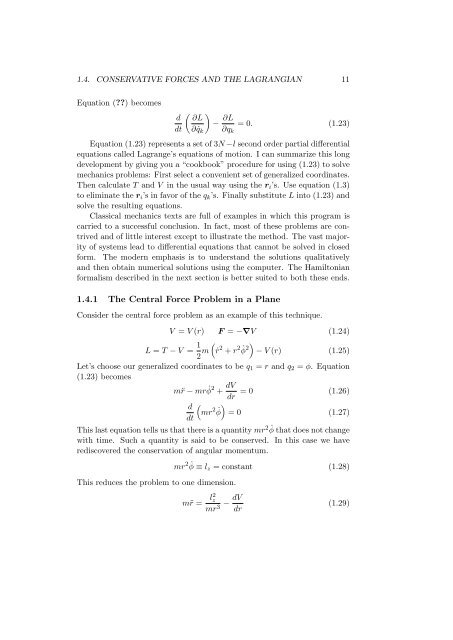Nonlinear Mechanics - Physics at Oregon State University
Nonlinear Mechanics - Physics at Oregon State University
Nonlinear Mechanics - Physics at Oregon State University
Create successful ePaper yourself
Turn your PDF publications into a flip-book with our unique Google optimized e-Paper software.
1.4. CONSERVATIVE FORCES AND THE LAGRANGIAN 11<br />
Equ<strong>at</strong>ion (??) becomes<br />
d<br />
dt<br />
( ∂L<br />
∂ ˙qk<br />
)<br />
− ∂L<br />
∂qk<br />
= 0. (1.23)<br />
Equ<strong>at</strong>ion (1.23) represents a set of 3N −l second order partial differential<br />
equ<strong>at</strong>ions called Lagrange’s equ<strong>at</strong>ions of motion. I can summarize this long<br />
development by giving you a “cookbook” procedure for using (1.23) to solve<br />
mechanics problems: First select a convenient set of generalized coordin<strong>at</strong>es.<br />
Then calcul<strong>at</strong>e T and V in the usual way using the ri’s. Use equ<strong>at</strong>ion (1.3)<br />
to elimin<strong>at</strong>e the ri’s in favor of the qk’s. Finally substitute L into (1.23) and<br />
solve the resulting equ<strong>at</strong>ions.<br />
Classical mechanics texts are full of examples in which this program is<br />
carried to a successful conclusion. In fact, most of these problems are contrived<br />
and of little interest except to illustr<strong>at</strong>e the method. The vast majority<br />
of systems lead to differential equ<strong>at</strong>ions th<strong>at</strong> cannot be solved in closed<br />
form. The modern emphasis is to understand the solutions qualit<strong>at</strong>ively<br />
and then obtain numerical solutions using the computer. The Hamiltonian<br />
formalism described in the next section is better suited to both these ends.<br />
1.4.1 The Central Force Problem in a Plane<br />
Consider the central force problem as an example of this technique.<br />
V = V (r) F = −∇V (1.24)<br />
L = T − V = 1<br />
2 m<br />
(<br />
˙r 2 + r 2 ϕ˙ 2 )<br />
− V (r) (1.25)<br />
Let’s choose our generalized coordin<strong>at</strong>es to be q1 = r and q2 = ϕ. Equ<strong>at</strong>ion<br />
(1.23) becomes<br />
m¨r − mr ˙ ϕ 2 + dV<br />
= 0<br />
dr<br />
d<br />
(<br />
mr<br />
dt<br />
(1.26)<br />
2 )<br />
ϕ˙<br />
= 0 (1.27)<br />
This last equ<strong>at</strong>ion tells us th<strong>at</strong> there is a quantity mr 2 ˙ ϕ th<strong>at</strong> does not change<br />
with time. Such a quantity is said to be conserved. In this case we have<br />
rediscovered the conserv<strong>at</strong>ion of angular momentum.<br />
This reduces the problem to one dimension.<br />
mr 2 ˙ ϕ ≡ lz = constant (1.28)<br />
m¨r = l2 z dV<br />
−<br />
mr3 dr<br />
(1.29)
















